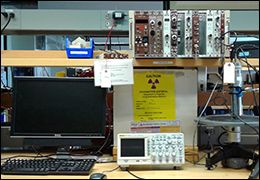Description

Compton scattering experiment equipment.
Compton scattering, discovered by Arthor H. Compton, is the scattering of high-energy photons by electrons. High-energy (662 keV) photons in a collimated beam from a radioactive 137 Cs source are scattered from electrons in a target which is itself a scintillation counter which detects the recoil electron. The scattered photons are detected in a second scintillation counter. The distribution in size of pulses from either the target or the scatter counter are recorded by a multichannel analyzer gated by pulses from a coincidence circuit activated by coincident pulses from the two detectors. In the first part of the experiment both scintillators are NaI crystals, and the energies of the scattered photons and the recoil electrons are measured as functions of the scattering angle; the results are compared with the theory of Compton scattering.
In the second part the target is a plastic scintillator, and the relative intensities of scattered photons are recorded at several scattering angles. The results, normalized to a separate measurement of the total scattering cross section of the plastic scintillator, are used to derive the differential scattering cross section; the results are compared with the Thomson and the Klein-Nishina formulas for the scattering of photons by free electrons.
Lab Guide
Compton Scattering Lab Guide (PDF)
References
Compton, Arthur H. Nobel Prize Lecture, “X-rays as a Branch of Optics.” (1927).
———. Abstract for “Wave-length Measurements of Scattered X-rays.” The Physical Review 21 (1923): 715.
———. “The Spectrum of Scattered X-Rays.” The Physical Review 22, (1923): 409-413.
———. “A Quantum Theory of the Scattering of X-Rays by Light Elements.” The Physical Review 21, (1922): 483-502.
Hofstadter, Robert, and John A. McIntyre. “Measurement of Gamma-Ray Energies with Two Crystals in Coincidence.” The Physical Review 78 (1950): 619-620.
Lazar, N. H., R. C. Davis, and P. R. Bell. “Peak Efficiency of NaI.” Nucleonics 14 (April 1956): 52.
Melissinos, Adrian C. “Compton Scattering.” In Experiments in Modern Physics. San Diego, CA: Academic Press, 1966, pp. 253-265.
Garner, R. P., and K. Verghese. “On the Solid Angle Subtended by a Circular Disc.” Nuclear Instruments and Methods 93 (1971): 163-167.
Higbie, J. “Undergraduate Relativity Experiment.” American Journal of Physics 42 (1974): 642-644.
Knoll, G. F. “Optimization of Counting Experiments.” In Radiation Detection and Measurement. 3rd ed. New York, NY: John Wiley, 2000, pp. 92-95. ISBN: 9780471073383.
———. “Radiation Spectroscopy with Scintillators.” In Radiation Detection and Measurement. 3rd ed. New York, NY: John Wiley, 2000, pp. 306-355. ISBN: 9780471073383.










